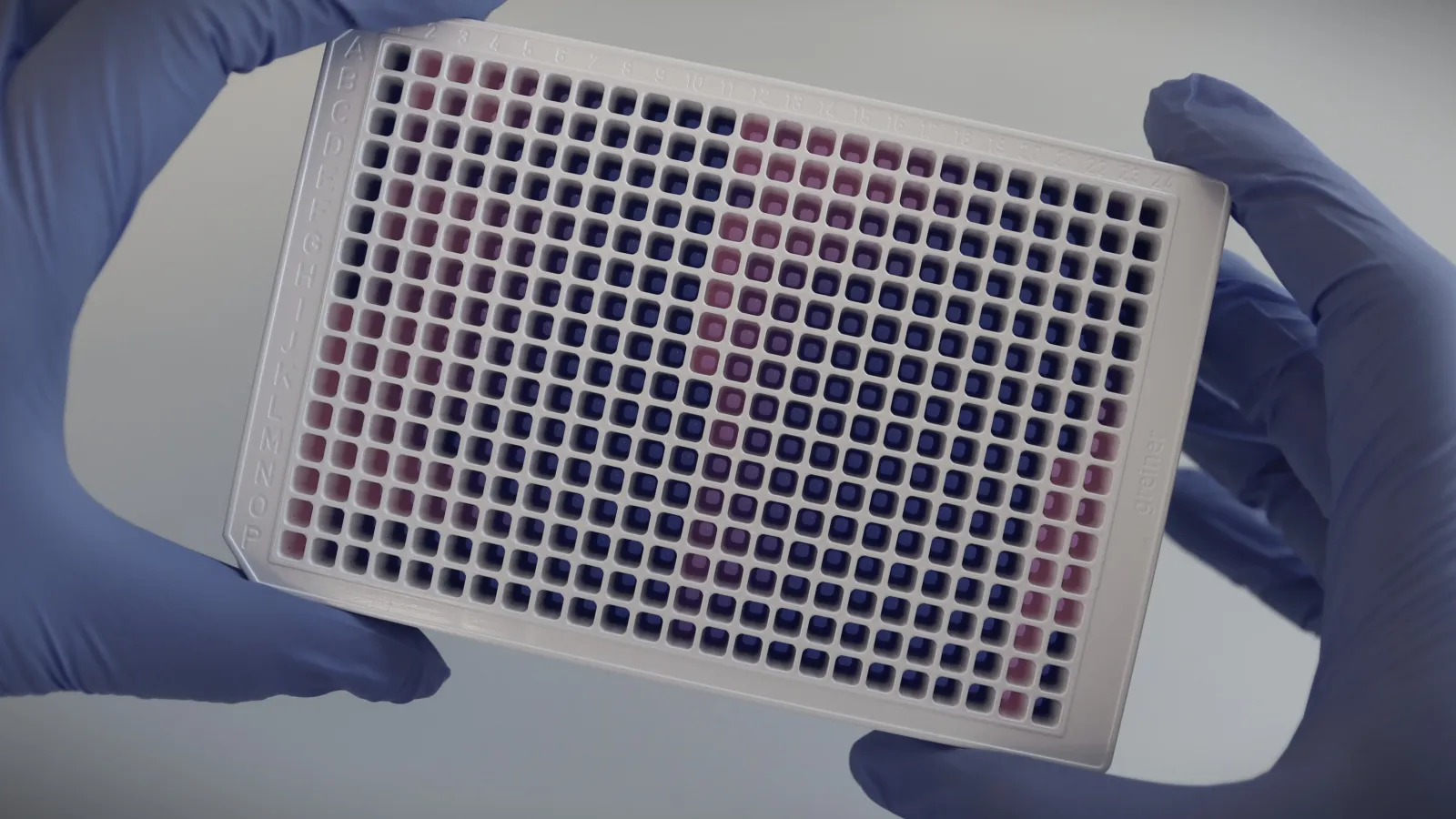

Phenotypic Assays
Excellerate’s team of scientists are highly experienced in the development of in vitro phenotypic assays to report functional outcomes in relevant human cells and deliver actionable data.
Our reputation extends beyond target-directed pharmacology to dedicated expertise in human primary cell biology, and its application to target validation, screening programs, and mechanism of action studies.
We offer a comprehensive range of phenotypic assays tailored to meet your drug discovery project requirements.
Our Capabilities
Cellular & Phenotypic Assays
Phenotypic Assays
Cell Health & Viability
Excellerate recognize the importance of identifying potential cytotoxic effects and ensuring the safety of new compounds early in the development process.
By assessing parameters like cell viability & cytotoxicity, Excellerate support you making informed decisions about progressing drug candidates through your project pipeline.
We provide an extensive range of cell health assays designed to meet the needs of your drug discovery program including:
Cell Viability & Cytotoxicity: Assessment of cell survival in response to compound treatment (MTT/AOPI/ATP-based readouts).
Apoptosis & Necrosis: Analysis of apoptosis and necrosis cellular pathways with compound panel treatment (caspase 3/7 activity, annexin V, LDH release).
Cell Cycle Assessment: Quantify compound effects on cell cycle progression (PI staining or full 4-colour immunofluorescent approach for G1/S/G2/M phase, cellular senescence).
ROS Production: Determine compound effects on cellular ROS production, both cytoplasmic and mitochondrial specific ROS (ROSglo, CellROX, MitoSox).
Proliferation & Differentiation
Proliferation and differentiation assays offer insights into compounds effects on cell growth and lineage development. These readouts can identify potential therapeutic and cytotoxic effects, providing a deeper understanding of drug actions in relevant cellular/disease models.
Excellerate provides a platform for evaluating compound effects on cellular proliferation and differentiation, including:
Proliferation Assessment:
BrdU/EdU Incorporation: Measures proliferation through nuclei immunofluorescence counts, or DNA synthesis to assess cell proliferation rates. We can further characterize all stages of the cell cycle to investigate cell cycle arrest and senescence.
Oncology Focus: Routine use of disease relevant cancer lines to study susceptibility to compound-induced cell death, linking findings to modalities and targets.
Differentiation Models:
Fibrosis Models: Fibroblast-to-myofibroblast and epithelial-mesenchymal transition assays (FMT/EMT); quantification of compound effects in differentiation process biomarkers and extracellular matrix deposition in cell lineages relevant to fibrosis.
Whole Blood/Primary Cell Differentiation: Effects of compounds on immune cell differentiation, marker expression and function (e.g. monocyte-to-macrophage differentiation/polarization studies).
Neuronal Differentiation: Compound effects on neurite outgrowth and neuronal development.
Osteogenesis, Adipogenesis & Myogenesis: Investigate effects of compounds on differentiation and phenotypic activity of osteoclast/osteoblast on bone formation/resorption, adipocyte differentiation/lipid droplet accumulation, or muscle cell formation and development.
Metabolic Assays
Metabolic assays provide insights into cellular energy production and metabolic pathways. By analyzing metabolites, cellular respiration, and mitochondrial function, we can understand how compounds affect cellular metabolism and identify potential therapeutic targets.
Excellerate provide a panel of assay approaches deliver detailed insights into how drug candidates influence cellular metabolism:
Metabolite Quantification: Quantification of compound effects on cellular metabolite concentrations (e.g. cellular glucose, lactose, NAD/NADH ratios).
Cellular Respiration: Measurement of compound effects on cellular respiration in with hypoxia/atmospheric control to better mimic disease microenvironments in vitro.
OxPHOS vs Glycolysis: Rates of glycolytic flux and OxPHOS activity/ETC activity, and quantification of compound effects on metabolic switches such as Warburg effect.
Seahorse XF - Comprehensive analysis on cellular respiration with quantification of OCR/ECAR and source of cellular ATP generation.
Mitochondrial Functioning: Measurement of mitochondrial functioning/health with compound treatment including mitochondrial membrane potential, ETC activity and mROS production.
Migration, Motility & Wound Healing
Understanding how cells migrate and their involvement in wound healing is critical for evaluating therapeutic potential of new compounds, particularly in cancer, inflammation, and tissue repair contexts.
Excellerate offers a comprehensive and robust suite of assays to support your drug discovery program to track cellular migration, motility, and wound healing, including:
Cell Migration & Motility:
Cell Tracking and Morphology: Analysis of cell growth patterns, changes in morphology, and differentiation in response to compounds.
Chemoattraction Assays: Quantify cell movement in 2D (membranes) or 3D (inserts) in response to chemokine gradients, providing insights into directed migration and metastatic potential.
Invasion Assays: Assess compound effects on cell invasion through extracellular matrices using transwell inserts.
Wound Healing Assays:
Scratch/ORIS Assays: Quantify wound closure rates in monolayer cultures to evaluate compound effects on cell proliferation and migration during wound healing using scratch or barrier (ORIS system).
Cellular Imaging
By employing advanced imaging techniques, we can observe the effects of compounds on cell morphology, function, and behavior in real-time. Our cellular imaging assays provide deep insights into the cellular and molecular mechanisms of action and enable pharmacological profiling of compound efficacy.
High-Content and Live Imaging:
Automated, high-throughput imaging and analysis to assess phenotypic responses and target expressions.
Quantification of multiparametric data to evaluate compound effects on cell health, morphology, and function.
Real-time observation of compound effects on dynamic cellular processes, including cell migration, division, and interactions.
Localization Studies:
Target Engagement: Visualization of labelled compound binding to cellular targets, confirming specificity and efficacy.
Internalization & Endocytosis: Tracking of compound uptake and intracellular trafficking to understand delivery and mechanism of action.
Cellular Processes, Morphology, and Ultrastructure:
Neurite Outgrowth: Assessment of neuronal development and response to compounds, critical in neurodegenerative and neuroregenerative research.
Mitochondrial Function: High-resolution imaging of cellular mitochondrial networks to assess their health, dynamics, and function in response to compound treatments.
High-Resolution Visualization: Detailed characterisation of cellular ultrastructure and morphology to understand phenotypic changes induced by compounds.
Phenotypic Assays
Flow Cytometry & Immunophenotyping
Detailed characterization of cell populations and their functional states is essential for understanding the immune landscape and cellular responses to drug candidates. Excellerate offers comprehensive multiparametric flow cytometry and immunophenotyping services to provide in-depth analysis of surface markers, lineages, and intracellular protein targets.
Cell Population Characterization:
Detailed analysis of cell populations, including lineage-specific markers and phenotypic profiling.
Quantification and sorting of distinct cell subpopulations for downstream phenotypic analysis.
Surface Marker and Intracellular Analysis:
Identification and quantification of surface proteins to profile cell types and their differentiation & activation states in up to 384-well plate format.
Immunofluorescent staining of intracellular target proteins to study signalling pathways and functional responses.
Primary Cell & Whole Blood Assays
At Excellerate Bioscience, we understand that physiologically relevant models are critical for accurately predicting the efficacy and safety of drug candidates. Our Primary Cell and Whole Blood Assays provide robust and reliable data by leveraging the complexity and authenticity of human-derived cells and tissues.
Primary Cell Assays:
Primary cells, isolated directly from human tissues, retain the characteristics of their tissue of origin, providing a more accurate representation of in vivo conditions compared to immortalized cell lines. Our primary cell assays encompass a wide range of cell types, including human lung fibroblasts, human umbilical vein endothelial cells and human blood cell types.
Whole Blood Assays:
Whole blood assays provide a comprehensive approach to studying compound effects on the immune system, preserving the natural interactions between different blood cell types. Our whole blood assays include:
Cytokine Release Assays: Measure the production of cytokines in response to drug treatments, crucial for assessing immunogenicity and potential inflammatory responses.
Flow Cytometry Assays: Analyse cell surface markers, immune cell populations, and intracellular signalling pathways within whole blood, offering comprehensive insights into immune modulation.
NETosis: Fluorescent imaging approaches to visualize and measure neutrophil NETosis and quantification of activation and degranulation status.
Phagocytosis and ADCC Assays: Evaluate the functional activity of immune cells, such as macrophages and NK cells, in mediating phagocytosis and antibody-dependent cell-mediated cytotoxicity.
Target Engagement & Expression Studies
Understanding the effects of target engagement on cellular phenotypes is important in understanding the mechanism of action of a candidate drug.
At Excellerate, we employ a wide range of experimental approaches to reveal molecular interactions and biological pathways that underpin compound efficacy, leveraging cutting-edge techniques and customized solutions.
Pathway Analysis:
Phosphorylation/Secondary Messenger Signaling: Assessment of phosphorylation/secondary messenger levels via Western blotting or fluorescent plate-based assays (HTRF).
Calcium Mobilisation: Fluorescent identification of rapid intracellular calcium mobilisation using automated pipetting systems.
Protein-Protein Interaction: Measurement of drug-induced PPIs with fluorescent/luminescence plate-based approaches.
Expression Analysis: Measurement of gene expression by qPCR and protein expression by Western blotting or IF approaches.
Reporter Assays: Measurement of signaling activity downstream of target engagement using reporter cell lines.
Bespoke ELISAs /Multiplexed Systems:
Custom assays to measure cytokine or substance secretion with high specificity and sensitivity to quantify immune responses and signaling pathway activity.
Multiplexed measurement of multiple analytes revealing a comprehensive profile of cytokine networks and interaction effects.
Knockout Studies:
Gene-specific knockout validation using siRNA or CRISPR-Cas9 technology: These studies aid in understanding the biological consequences of target inhibition, providing critical data for target validation studies and understanding mechanism of action.
Cell Models & Complex Systems
We recognize the importance of utilising advanced cell models and complex systems to more closely replicate in vivo disease conditions when predicting drug efficacy.
Excellerate offer a panel of cell models to suit your different research needs, including primary cells, immortalized cell lines and reporter cell lines. These systems are selected to provide you with robust, physiologically relevant data and include:
Primary Cells: Freshly isolated from tissues, these cells maintain physiological properties and provide more accurate biological responses.
Immortalized Cell Lines: These cell lines offer a reliable and consistent model for high-throughput screening and mechanistic studies.
Reporter Cell Lines: Utilizing technologies such as luciferase, GFP/RFP, and beta-galactosidase, reporter cell lines deliver real-time insights into gene expression, signaling pathways, and cellular processes.
Spheroids: Multicellular aggregates mimicking the 3D organization of tissues and hypoxic development and provide a more complex and physiologically relevant environment compared to traditional cultures.
Co-Culture Models: Combinations of different cell types, such as tumour cells and immune cells, to study cell-cell interactions.
Discover More

